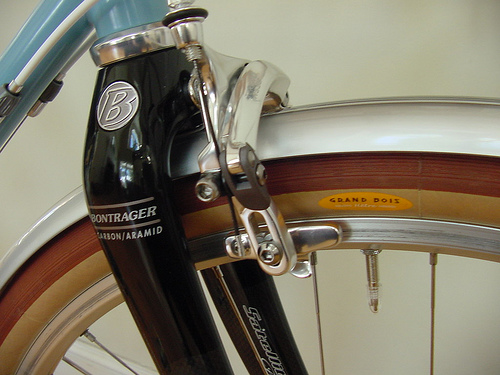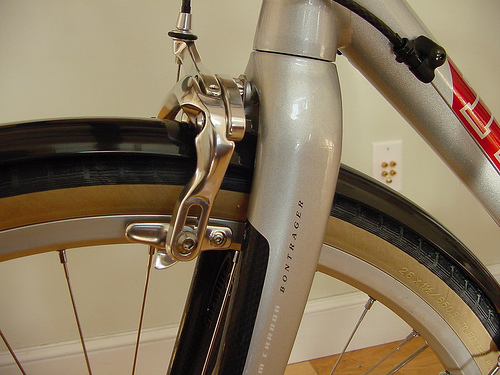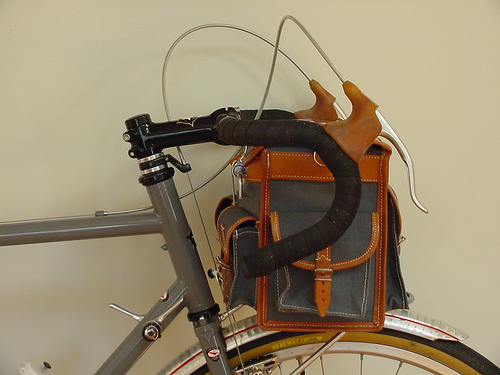650B Superbike
by Ed 650Braley • July 31, 2023
Originally Published March 27, 2009

When the 650B wheel was reintroduced a few years ago, the model we were following was the randonneuring and cyclotouring bicycle built in the French tradition. Many of us had spent considerable time studying these old French machines, and we could see how these marvelous bikes would be practical in everyday use. The large volume 650x38B tires were meant to carry the rider comfortably over a variety of road surfaces. The bikes were equipped with lights, fenders, and luggage systems for extended journeys and practical use in all conditions. They had a combination of attributes that made them unique and versatile, and they were beautifully executed.

When our 650B renaissance began there was an article published in the Rivendell Reader about converting existing bikes to 650B, and there was some subsequent dialog on the Internet about doing this with our own bikes. It was then that I had my big revelation about the 650B wheel - that it was possible to convert many of the millions of existing bicycles to the 650B format, allowing the bikes to be reconfigured with bigger, more comfortable tires, suitable for use over varied road surfaces, and equipped with fenders for foul weather. And, as we soon discovered, with good quality tires the bikes would retain the handling and much of the speed of the original 700C format, and they were extremely comfortable to ride over rough roads. The bicycles that I proceeded to convert to 650B at that time all confirmed it. And many of you have discovered this also. For the past few years converting bikes to 650B has been my thing, and this 650Blog is the vehicle I've used to communicate some of my insights, ideas, and project accomplishments beyond the email lists. Well, one day I got an idea, and it was so simple - so obvious, that I was surprised we hadn't thought of it yet...

It occurred to me that the properties of the 650x38B wheel which made these conversions so successful in the older bikes were also appropriate for today's high technology bikes, even if the new bikes didn't follow the original model of the vintage randonneur. In fact, the newer bikes have technologies that could best utilize the strength and versatility of the smaller wheel with the wider tires, and, that these strong and comfortable wheels would minimize some faults of the new bikes. For example, the harsh ride attributed to aluminum frames would be a non-issue with 38mm tires; there is certainly no need for buzz-killing inserts when your bicycle is cushioned by a 38mm tire inflated to 45psi. And the stiff lightweight frames, threadless steerers, and carbon forks would be ideal for hard riding over the rough and loose surfaces made easily passable with the bigger 650B tires. The primary driver behind many of these standards is the mountain bike segment of the market, where rim brakes are now all but obsolete - they've been replaced by disc brakes. Disc brakes are also common on many urban bicycles, they provide superior stopping power in wet conditions and preserve the rims. So, to take this idea one step further, I realized that the use of a disc braking system would also eliminate one of the challenges we'd encountered in doing the 650B conversions. A disc braking system is not affected by changes in the diameter of the rim. The modern high technology bicycle and 650B; it seemed like a perfect match. And it is!

Oh, we had considerable dialog about this idea on the 650B email list when I first proposed it. It generated one of the most active periods of posting we had ever experienced. It was a controversial, and mind-blowing thing for some people. It was new direction, it didn't seem follow the old pattern - it was a new model. We started calling them 650B Superbikes, and even if it is a bit bold, I still like to use that term, because it's simple and distinctive. The truth is, this is not nearly as radical an idea as it would seem. The French constructeur bicycles were very advanced for their time, they were the 650B Superbikes in their era. They were not production machines as we think of them today. They were custom, expensive, and of limited availability, like the new artisan-built 650B bikes. But there were production examples offered years ago, and they incorporated some of the designs first used on those constructeur machines. If the French Technical Trials of the 1940's had continued to our day I have no doubt that the entries would be utilizing technologies similar to those that we find on today's high-end bicycles. There was some planning for a new series of Technical Trials here in the US, but unfortunately, that never happened, so we can only guess at what might have been.

There have been a few custom 650B Superbikes created in the last couple of years, some have used modern integrated drivetrain components, titanium frames, and disc brakes. But as of yet there are no stock offerings, no production models, available from the bicycle companies. If there were, they would certainly utilize the same advanced construction techniques, materials, and technologies found on today's road racing and off-road machines. It's easy to visualize such a machine: When you look at the new racing and fast touring bikes in the shops, imagine them configured with a set of lightweight 650B wheels, high quality tires, some lightweight fenders, and perhaps lighting and luggage systems. No, most of these new bikes won't actually have the clearances required for big 650B tires, but a few of them do, and they can be easily converted to 650B.

By virtue of the fact that 650B conversions work so well, it was clear that we could build modern high technology 650B wheeled bicycles on one or more of these platforms, creating production-quality 650B Superbikes that might take years for the bicycle companies to offer as standard products. We could create advanced, fast-touring, rough-road machines with existing products. The conversion of these complete production bicycles is the quickest, easiest, and least expensive way to reap the benefits of 650B in bicycles with frames built of lightweight materials and equipped with high technology drivetrain components. And there is no risk, because we're not making any permanent changes to the bikes, they can be restored to 700C quickly and easily. Yes, conversions are my thing, and for me, it was clear that this is the way forward. I know that I can build something that the bicycle companies are not yet offering, and I can use stock parts to do it. So can you!

There is a compromise in this approach that pertains to load carrying, and I want to spend a moment on that. The French low-trail front end geometry which favors front-loaded carrying of luggage in handlebar bags and on large platform racks is not typical of today's production bicycles, and critics of this approach are certain to make mention of this fact. So if a front-loaded touring bike is what you require, then you should consider a custom frame, or building on the steel Kogswell P/R frame and low-trail fork. Obviously, not everyone requires capacity for front-loaded touring at all times, so for many this is not an issue. Personally, I don't like having a heavy handlebar bag on the front of my bike, even though they certainly are convenient at times. Most of my own rides are typically fast day-touring adventures, I want a lightweight bike, and I am well served with a mid-sized seat pack on my 650B machines. I've also come to appreciate the convenience of STI controls whose cable routing usually conflicts with the location of a handlebar bag. We could discuss and debate front end geometry forever. But there will be few, if any, 650B compatible production bicycles available with high technology designs, materials, and components and a low-trail front end intended for front-loaded carrying. Some will come close, and that may be quite acceptable in mixed use. You should determine what you require and decide what's best for you.

So, then, progressing toward my vision of the modern 650B Superbike, the question became: What was possible with existing bikes? Which bicycle companies produced models that could be converted to 650B? After a little research I identified a few prospects, including two models from Trek; the 1200c and the Pilot 2.1. I built the 1200c from the frameset, and I purchased a new Pilot 2.1 through Bikeman for our project bike. You will find these bikes in the archives of this 650Blog. These bikes were the lightest, and fastest 650B machines that I had ever built. And the 1200c had more tire clearance than any other 650B conversion I'd done. To this day, the Pilot 2.1 is perhaps the most advanced production bicycle converted to 650B. It was a new vector; a carbon fiber and aluminum frame with compact geometry, an outboard bearing crankset, an integrated headset, and a modern 30 speed STI drivetrain. Right out of the box, it was easily reconfigured with 650x38B tires and wheels, long reach dual pivot brakes, and thermoplastic fenders. I called it "22 pounds of 650B rocketry" at the time, and it still is! That bike is very fast over rough roads, it's fast on smooth pavement, it handles beautifully, and it's comfortable everywhere you go. All of the benefits of 650B in a high-tech bicycle are there. In some respects the 650B Soma Speedster is a retro styled steel frame variant of the modern 650B machine, a kind of 650B hot rod. And the 650B converted Surly Pacer with the carbon fork that you just saw here on the 650Blog is yet another example with some of the attributes that I'm describing.

There are more technically advanced bikes with the potential to be run on the 650B format, and I'd like to see how far I can take this concept with today's stock products. My personal challenge is to find and build the most modern, lightweight, production-quality 650B machine possible with what's commercially available. A full carbon fiber 650B Superbike would be very interesting, and I'd love to ride one on a fast set of wheels. But I have yet to find a frame with the clearances required for the big tires, so the search continues.

There has been great progress in the world of 650B recently. Most significantly, there are new mountain bike tires being produced for 650B, and we are seeing new rims, and tubeless 650B wheels designed for use with disc braking systems. Many companies have decided to enter the 650B mountain bike market with both custom and production machines utilizing these products.
These new tire, braking, and wheel systems have applications in the road bike space as well. The new and versatile Rawland Sogn frameset is available in a disc brake version, for example. And you probably saw our recent conversion of the Salsa La Cruz here at Bikeman. For that bike we took an extreme approach and fit 650B 2.0 knobby tires in a frame designed for 32mm tires on 700C wheels, creating a monster cross disc brake 650B conversion. We can easily fit that same bike with 650x38B randonneuring tires and fenders. The tubeless system can certainly work for road going machines if used with the right tires and rims. At the high end, the performance of such a wheel system could approach the levels of speed and comfort typical of a good quality tubular wheelset. This is all new, and it's still developing. The bicycle companies are just beginning to offer the 650B format on mountain bikes, and it may still be a year or more before they offer fast-touring bicycles with 650B wheels as standard products. But we can have some fun in the meantime. It could play-out like the fixed-gear scene: They'll see what we're doing and eventually pick up the trend ;-)
So, again, the question is: What is possible now, today? Which complete bicycles can accept the 650B wheel with the large road tires? What kind of 650B Superbike can we build with production components, utilizing the best current technologies available commercially to anyone now?
I like to think about this concept- it's exciting! And we can make it real. We don't have to wait for the bicycle companies to create and market 650B Superbikes - we can build them ourselves! We can create some rather amazing 650B bikes today! In fact, there is one in my work stand right now as I write this entry for the 650Blog... And you will see it soon!
Ed 650Braley
